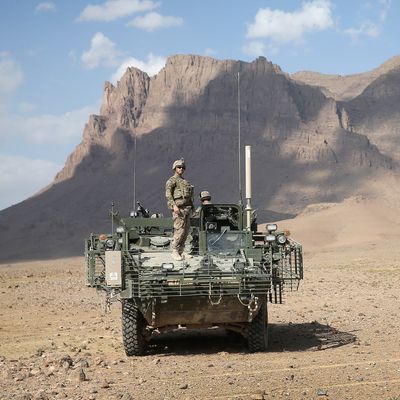
At first glance, reports that Trump administration negotiators are very close to the outlines of a peace deal with the Afghan Taliban may seem a little far-fetched. These are, after all, the same negotiators who brought us a U.S. summit with Kim Jong-un that has seen North Korea’s nuclear weapons programs advance, a trade war that is depressing the U.S. economy, and a month-long government shutdown that ultimately failed to deliver any money for Trump’s border wall.
The Taliban, for their part, know a thing or two about incompetence and disaster — they ran Afghanistan into the ground in the years they were in charge, driving economic and health outcomes backward while striking a deal with Al Qaeda that, after 9/11, sparked the U.S. invasion that drove them from power.
But the Taliban also know how to endure. It has been apparent to some American observers for more than a decade that in the long run they would have to be part of any peace deal for the country. Negotiations were on and off again throughout the Obama years, over the same sticking points: The Taliban doesn’t want to deal with the government of Afghanistan, and it wants the U.S. to set a timetable for removing all its troops before other topics are agreed upon.
Why negotiate at all? Although it has fallen off many Americans’ radar, the war in Afghanistan remains the most deadly conflict in the world, according to the Armed Conflict Location & Event Data Project (ACLED). The year 2018 was particularly grim — 15 American service-members were killed, and as NPR noted, the number of fatalities among Afghan civilians and security forces was staggering:
Violence claimed the lives of nearly 3,000 civilians between Jan. 1 and Sept. 30, the highest number in that same period since 2014. The death toll of Afghan security forces — which some estimates put at more than 9,000 this year, between 25 and 30 deaths a day — has been called “unsustainable” by the U.S. military.
The leading cause of civilian casualties was the use of improvised explosive devices, according to the U.N. There were suicide attacks and bombings at voting centers, schools and mosques. And there were U.S. airstrikes.
The Afghan government controls barely half the country’s territory, presidential elections have been postponed, and politics is bogged down. Not only is there no quick fix in sight, there is no medium-term fix in sight. And unfortunately, the suffering of Afghanistan doesn’t stay in Afghanistan — Al Qaeda and a powerful ISIS affiliate continue to operate out of remote Afghan areas, but with global reach.
At the same time, some things have improved dramatically in Afghanistan since the U.S. invasion. According to the World Bank, the number of children who die before reaching age 5 has fallen by 60 percent, and more than half of women giving birth now have skilled medical help. Foreign funding and support have meant that hundreds of thousands of children, including girls, have returned to school, and five times as many medical facilities are now open. This dynamic, with Afghans making some progress at unsustainable costs, has been tragically consistent for a decade or more.
In some ways, Trump’s inconsistency could help clear some of the previous hurdles in talks with the Taliban. At the beginning of his presidency, Trump acquiesced to his Cabinet and actually increased the number of U.S. troops on the ground, from 11,000 to 14,000. Late last year, the White House reportedly asked the Pentagon to look into multiple options in Afghanistan, including a complete withdrawal, but Trump settled on cutting the number of troops by half, leaving about 7,000. If this makes the Taliban believe he is serious about an eventual pullout, that may be helping to drive progress in the talks. Opponents of a pullout had long argued that a larger troop presence could drive lasting progress on the ground, but that hasn’t occurred under Trump — and didn’t under Obama either.
The idea of leaving even a small number of troops may anger U.S. withdrawal purists on both the right and the left, but it addresses concerns about continuing counterterrorism operations. It also signals to Afghan civilians and President Ashraf Ghani that Washington does not intend to leave them at the mercy of the Taliban, and negotiating would be worth their while.
But then comes the hardest question: with whom to negotiate? Washington will have to exert significant pressure and offer some rewards to keep Ghani’s government engaged — understandably, since it fears signing its own death warrant. But there is another problem that Ghani’s team and Trump’s share with their predecessors: a reluctance to broaden the talks to include civil society representatives. Afghan women have spoken up often, at great risk to themselves, to demand that their concerns be heard and their voices included. It is fashionable to write off this demand off as too idealistic, to say that there is no room in power politics for the weak, much less for thinking about gender and other social constructs. Hard, cold facts say otherwise. Peace processes that involve women, religious groups, human rights advocates and other non-state actors are less likely to fail, and more likely to last 15 years or more.
Nobody thinks President Trump cares about that — but the diplomats and generals on the ground, all of whom have now spent half their adult lives working on conflict in Afghanistan, should. And Americans at home, watching as the children of Afghanistan veterans get ready to deploy in America’s longest war, should too. It’s possible to be a cold-eyed realist who believes the war in Afghanistan can’t be won — and that Washington can only disengage successfully by making sure the concerns of women, minorities, and everyday Afghans are heard in a peace deal.





























